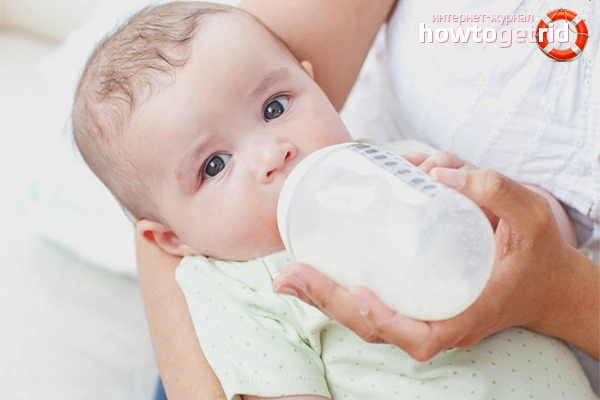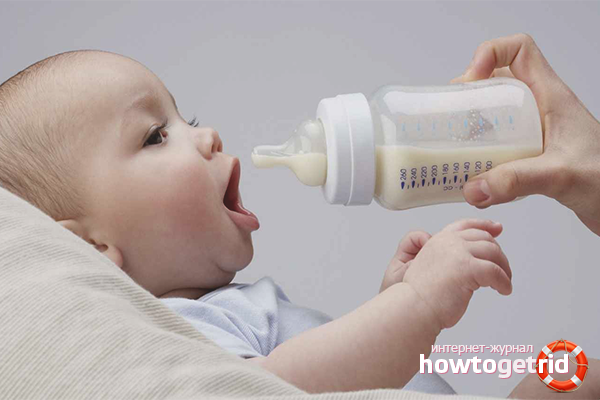The content of the article
Young mothers have to learn a huge amount of new information that they learn from a doctor, from the Internet or from more experienced friends. But sometimes this information is contradictory, doctors say one thing, and experienced mothers insist on another, based on practical experience. For example, breastfeeding counselors are strongly opposed to various soothers, nipples and small bottles, explaining this by the fact that the baby subsequently begins to give up breasts. But sometimes there are times when it’s vital to accustom a baby to a bottle. What situations are we talking about, let's try to figure it out.
In which cases you need to teach a child a bottle
In nature, animals do not need any additional devices to feed the cub. Normally, a person doesn’t need a bottle either - a baby can get food and drink from breast milk. The body is so arranged - the front milk in the woman’s chest is more liquid, almost like water, so that the crumbs can quench their thirst immediately after application. Back milk, which has to be drained with difficulty, is more dense and fat, it contains all the vitamins and nutrients. If the mother does not experience any problems with breastfeeding, does not leave the baby longer than two hours, then the bottle may never be useful to him. Such children, along with complementary foods, receive water and other drinks from drinkers and even immediately from a cup, bypassing the stage of accustoming to a bottle. However, such ideal situations are extremely rare, and often the mother is simply forced to accustom the child to the bottle.
- Artificial feeding. There are many cases in which the baby has to switch to artificial or mixed feeding. First of all, mothers who simply do not have breast milk, or very little of it, suffer. This happens extremely rarely, do not rush to switch to the mixture, try to establish lactation, and only after long unsuccessful attempts can you switch to artificial feeding. A bottle may be necessary if the mother received complications during childbirth and is forced to be treated with potent drugs. In this case, milk quickly burns out, it is almost impossible to restore lactation. And how many reasons can there be for artificial feeding? The absence of a mother nearby for more than five hours is already a good reason for accustoming to a bottle.
- Medication. Almost all babies in the first months of life suffer from colic. In the fight against gases and imperfect bowel function, pediatricians recommend various medications and decoctions that cope with excessive flatulence. Most often, in the fight against a sick tummy, dill water is used, which must be given using a bottle.
- Doping As noted, in the norm, the baby does not need to be doped with water, however, there are situations where additional fluid is simply necessary. Firstly, it is a disease, especially with temperature. You can cope with a viral infection only with the help of a large amount of liquid. Secondly, to drink often, but in small portions should be poisoned - this is a way to protect against dehydration. Thirdly, drink should be given to children who grow in a warm climate or are constantly in a hot room.
Be that as it may, but almost all mothers have to accustom the baby to the bottle, because the child needs to be drunk and reassured even on the street, where it is not always possible to bare the chest and start feeding. But how to do it right?
How to teach a child a bottle
Some mothers wonder why to teach, because babies usually start to suck water or a diluted mixture from a bottle without any problems. But, unfortunately, not all babies behave in this way, mom’s warm and soft breasts are much more pleasant and sweeter, so many women have to try pretty hard for the baby to take a pacifier.
- If you need to urgently accustom the baby to a bottle, do not offer him a pacifier on a full stomach. The kid simply does not understand what you want from him, and will spit out an unfamiliar object from his mouth. Wait for the baby to get hungry.
- Do not rush to immediately pour a bitter medicinal decoction into the bottle. First, you can teach your baby a bottle using water or a mixture that tastes similar to breast milk. As soon as you put the nipple from the bottle into the baby’s mouth, gently push it so that the baby feels the taste of the contents. It happens that parents decide to give their child a sour-milk mixture to normalize the stool, but when an acid product enters the mouth, the kids immediately abandon the bottle, and for a long time, maintaining unpleasant associations.
- If you have prepared water or a mixture for the crumbs, carefully monitor the temperature of the prepared liquid. It should not be cold or hot, only warm and comfortable for the baby.
- In some cases, the baby’s rejection of the breast is explained by the presence of an appetizing breast nearby. That is, with a greater likelihood, the baby will begin to suck the bottle that his dad or grandmother will offer him. If there are no assistants nearby, mother should plant the baby so that there is no breast in the access area.
- Well, of course, you should not accustom the baby to the bottle in emergency situations - in an unfamiliar environment, when the child has a stomach ache or teeth are cut.
- It happens that a child stubbornly pushes an unfamiliar object out of his mouth with his tongue. You can go for a little trick - to coat the nipple with your own breast milk or habit mixture. The baby will feel a familiar taste, begin to suck, the coveted liquid will pour from the bottle.
And further. If training does not require speed, do it gradually. First, show the child an empty bottle - let him examine it, play, touch. Then type the mixture into it, breast milk or water, apply to your lips. If the baby refuses, do not insist - offer a bottle tomorrow. Patience and love will help you overcome this temporary difficulty.
What kind of pacifier for a bottle to choose
The choice of nipples is incredibly important, especially for those who are mixed-fed. The fact is that milk from the nipple flows easily, without much effort. Kids quickly get used to the "lazy" way of feeding and refuse to breast, because you need to suck it well to get a delicious mommy's milk. To avoid this on a mixed diet and maintain lactation, you need to acquire anatomical nipples, the shape of which resembles the mother’s nipple. There is a rather small hole in such nipples, this does not allow the baby to be lazy, it will also suck the mother’s breast well. So that the child was comfortable and comfortable drinking from the bottle, you need to choose the right nipple for him.
- Material. Nipples can be made of latex, rubber, rubber, silicone. Each of the nipples has its drawbacks and advantages, the most safe and durable are silicone products.
- The size. The baby’s mouth grows every day, so when choosing a nipple you need to consider the age of the baby. All manufacturers make different designations on products. Most often, months - 0-3, 3-6, 6-12, etc. are indicated on the package. You can also see the notation in numbers - the first size for babies in the first half of the year, the second - from six months to a year, the third - for children older than a year. In such rulers, you can find a nipple that is designed for premature babies. When choosing a nipple, you can encounter such a designation - S, M, L, etc.
- The form. As noted, the choice of nipples is especially relevant for babies with mixed feeding, so that in the future the baby does not give up breasts. Such crumbs are offered an anatomical nipple - it is as close as possible in shape to the mother's breast, flattened on one side. In addition, there are standard nipples resembling an oblong shape. You can also pick up the baby's orthodontic form of the nipple, which will save the baby’s bite. While teaching a baby to a bottle, the choice of the shape of the nipples is very important, you can offer the baby different nipples, because he can refuse one, but fall in love with the other.
- Hole. As you know, in the nipple there can be one hole or several, the size of these holes is also different. The flow rate of the mixture depends on this. Babies in the first months of life need to pick up a bottle with one small hole. Firstly, the baby will not choke on the high flow rate. Secondly, it will teach the baby to suck intensively, the baby will not forget how to suck breast, you will be able to maintain lactation. As the child grows, the pacifier is changed, acquiring products with a large number of holes. Nipples with three to four large holes are designed for thicker mixtures - porridge, kefir, yogurt, etc. However, remember that in no case should you leave the child alone with a bottle - he may choke, you should be there.
Do not forget to change the nipples every three months, even if outwardly they seem to be intact. The fact is that the material of the nipple is quite porous, with prolonged use, harmful microorganisms penetrate inside. Be sure to change the pacifier to a new one if the hole for the passage of food becomes unusually large, otherwise the child may choke.
It happens that a child does not want to drink from a bottle in any way, no matter what nipple you offer him. In this case, you need to be patient and look for alternative solutions. Medications can be given to the baby with a small spoon or from a syringe without a needle. So that the baby does not choke, the medicine is administered by the cheek. If the baby is more than six months old, you can gradually accustom him to drink from a cup. But for young children with artificial feeding, the most difficult thing is if the child does not take the bottle, you need to look for other nipples, offer a different mixture, otherwise the baby will be left without food. The bottle is a very important baby accessory, even if the baby is fully breastfed. Teach the baby to the bottle, this is really necessary.
Video: how to feed a baby from a bottle











Submit